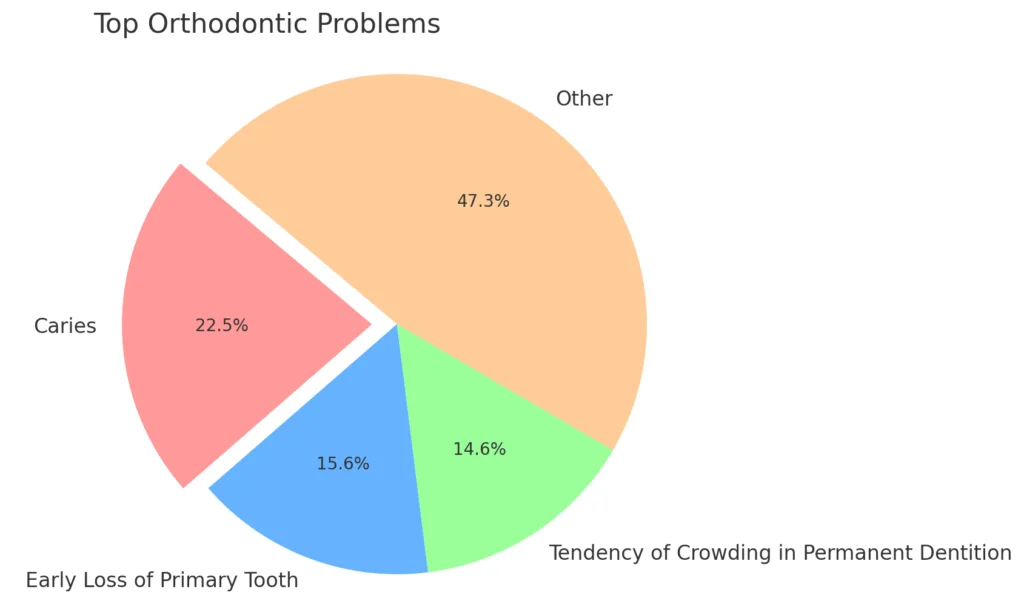A snaggle tooth is a single misaligned tooth, often caused by overcrowded teeth. Those with this issue may find their crooked or protruding incisor more noticeable than the rest of their smile. Having a snaggle tooth can be an uncomfortable experience that can lower your self-confidence and make it difficult to find the right treatment.
No matter what your age, a snaggle tooth can have far-reaching impacts if left untreated. As such, it’s important to understand the causes and treatment options so that you can start living more comfortably with a confident smile.
In this article, we’ll discuss the causes of a snaggle tooth and explore the different treatment options available, including braces and clear aligners.
What Causes a Snaggle Tooth?
A snaggletooth often results from a variety of dental conditions, with overcrowding being one of the most common. This occurs when there is insufficient space within the mouth for all teeth to fit normally, causing some to push against others and leading to misalignment or protrusion. Similarly, when teeth are larger than the jawbone can accommodate, they may not sit properly in the mouth, potentially resulting in a snaggletooth.
The premature loss of primary teeth can also contribute to this condition. If baby teeth are lost earlier than expected, the surrounding teeth may move into the vacant space, affecting the alignment of emerging permanent teeth and possibly causing them to erupt in an incorrect position. Furthermore, habitual teeth grinding, known as bruxism, can wear down teeth and weaken their structure, making them more likely to shift out of place.
Persistent thumb sucking is another factor that can lead to dental misalignments, including a snaggletooth. This habit can influence the shape and growth trajectory of both primary and permanent teeth, leading to issues like overcrowding.
Research featured in the Journal of the International Society of Preventive & Community Dentistry identifies the three most prevalent orthodontic issues as dental caries at 22.5%, early loss of primary teeth at 15.6%, and crowding in permanent teeth at 14.6%.

What Are The Risks of Having a Snaggle Tooth?
Having a snaggle tooth, where one or more teeth are misaligned or protrude beyond the others, can pose several risks beyond aesthetic concerns. Firstly, a snaggle tooth can complicate oral hygiene practices. Its irregular positioning often creates hard-to-reach areas that are challenging to clean effectively, increasing the risk of plaque buildup, tooth decay, and gum disease. Additionally, a misaligned tooth can affect the overall bite alignment, potentially leading to uneven wear on certain teeth, discomfort while chewing, and even temporomandibular joint (TMJ) disorders, which can cause pain and dysfunction in the jaw joint and muscles.
Furthermore, a snaggle tooth can contribute to speech impediments, as proper tooth alignment is crucial for clear articulation. In some cases, the protrusion of a snaggle tooth can also lead to physical discomfort or injury, especially if it rubs against the lips or inside of the mouth. Social and psychological impacts should not be overlooked either; people with visibly misaligned teeth might feel self-conscious about their appearance, potentially affecting their self-esteem and social interactions.
Thankfully, these risks are relatively minor if the issue is diagnosed early on; if possible, dental treatments such as clear aligners or braces should immediately be sought to correct any irregularity and preserve overall oral health.
Snaggle Tooth Treatment
If you’re considering options to correct a snaggle tooth, there’s a variety of treatments available to suit different needs. From the well-known route of traditional braces to the more discreet choice of clear aligners, each method offers a way to improve your smile’s alignment. Let’s explore the available treatments and see how they can contribute to a healthier, straighter smile.
Metal or Porcelain Braces
Metal braces are a traditional and highly effective method for correcting various dental alignment issues. They are made from high-grade stainless steel and consist of small brackets that are attached to each tooth. A metal wire, known as the archwire, is threaded through these brackets and held in place by tiny elastic bands called ligatures. The archwire is key to the treatment process, applying continuous pressure to the teeth to gradually move them into the correct position. Regular adjustments by an orthodontist are necessary to maintain the right amount of pressure, facilitating the teeth’s movement toward their desired alignment.
Porcelain braces serve as a more aesthetic option, constructed from ceramic materials designed to mimic the color of natural teeth, making them less noticeable. These braces also utilize brackets and an archwire to move the teeth, similar to metal braces. However, ceramic brackets are often larger and more fragile than metal ones, necessitating careful handling. Despite their subtler appearance, porcelain braces operate on the same orthodontic principles as metal braces, using sustained pressure to adjust tooth alignment.
See our article: Options to Straighten Teeth.
Clear Aligners and Invisalign
Clear aligners are custom-made from a clear, flexible plastic material that fits snugly over your teeth. The creation of these aligners begins with a digital scan or an impression of your mouth, ensuring that each aligner is perfectly tailored to the individual contours of your dental structure.
The treatment works by applying gentle, consistent pressure to the teeth, to gradually shift them into their desired alignment. Patients receive a series of aligners throughout their treatment, each one slightly different from the last. This progression allows for a step-by-step adjustment of the teeth’s position. Typically, you’ll move on to a new set of aligners every one to two weeks, with each new set bringing you a step closer to your ideal smile.
One of the major advantages of clear aligners is their subtle appearance and removability. They are almost invisible when worn. Moreover, they can be easily removed for eating, brushing, and flossing.
See our Clear Aligners Vs Invisalign comparison.
Here are some reviews of the best available invisible aligners:
Byte Review – The best pick and the most affordable option. A lifetime guarantee for peace of mind and a free HyperBite and teeth whitening kit are on offer.

Byte
An affordable option with refundable impression kits, free HyperByte, and a Byte for Life guarantee.
Check out Byte AlignersCandid Review – The most similar product to Invisalign Aligners this product has excellent reviews. Hybrid in-office care is offered too.

Candid
A hybrid of in-office and at-home treatment that provides 1-on-1 orthodontist support.
Check out Candid AlignersALIGNERCO – The cheapest with a zero deposit option for monthly payment plans. This product is available for as little as $945.

AlignerCo
The cheapest at-home aligners, with monthly plans, no down payment, and considerable discounts.
Check out AlignerCo AlignersVeneers
Veneers are thin shells made from porcelain or composite resin, custom-crafted to fit over the front surface of teeth. They are designed to conceal various dental imperfections, including misalignments like a snaggle tooth. The creation of veneers involves taking precise impressions of the affected tooth, ensuring the final product closely matches the natural color and shape of the surrounding teeth for a seamless appearance.
The application process requires minimal preparation of the tooth’s surface. A small amount of enamel is removed to accommodate the veneer, ensuring a flush fit against the tooth. The veneer is then securely bonded to the tooth using a durable dental adhesive, instantly altering the tooth’s appearance.
See our article: Veneers Pros and Cons.
Worth Knowing
A study published in Open Access Maced J Med Sci. comparing dental veneers’ survival rates based on preparation designs and materials found that porcelain veneers offer superior aesthetic results and long-term reliability. Composite veneers are a good option but have slightly less durability. This information aids in selecting the most suitable veneer material and preparation design for optimal treatment outcomes.
Tooth Contouring
Tooth contouring typically involves reshaping the tooth, shaving off any rough edges, and removing discolorations or irregularities to make it even with the other teeth.
The process involves the orthodontist trimming down your existing tooth, reducing its size, and reshaping it as you desire. It’s generally considered a conservative approach to cosmetic dentistry because it doesn’t involve adding material to your teeth or using any prosthetic components.
As such, it often doesn’t require anesthesia and is highly cost-effective as well. While this procedure cannot make radical changes in tooth shape, it can give patients straighter, brighter, and more evenly shaped teeth without involving surgery.
Frequently Asked Questions
What is the Cheapest Way to Fix a Snaggle Tooth?
Clear aligners are an efficient, budget-friendly option when it comes to fixing a snaggle tooth, and offer a quicker resolution time to treatment in mild to mid conditions than other more traditional options.
What is the Fastest Way to Fix a Snaggle Tooth?
Clear aligners offer an efficient solution to dealing with a snaggle tooth and do so quicker than other treatment methods. Clear aligners also offer a more aesthetic treatment than other types and are a great solution for mild to mid issues.
Can I Fix a Snaggle Tooth Without Braces?
Invisalign or other clear aligners can treat a snaggle tooth that is mildly to moderately misaligned as well as braces can. This type of treatment also offers a reduced treatment time with enhanced aesthetic benefits too.
Sources
Alothman, Y., Bamasoud, M. S., The Success of Dental Veneers According To Preparation Design and Material Type, Open Access Maced J Med Sci. 2018 Dec 20; DOI: 10.3889/oamjms.2018.353. Available online at: https://www.ncbi.nlm.nih.gov/pmc/articles/PMC6311473/
Rapeepattana, S., Thearmontree, A., Suntornlohanakul, S., Etiology of Malocclusion and Dominant Orthodontic Problems in Mixed Dentition: A Cross-sectional Study in a Group of Thai Children Aged 8–9 Years, J Int Soc Prev Community Dent, 2019, DOI: 10.4103/jispcd.JISPCD_120_19. Available online at: https://www.ncbi.nlm.nih.gov/pmc/articles/PMC6714419/
Saliba Moimaz, S. A., Ísper Garbin, A. J., Chaves Lima, A. M., Lolli, L. F., Saliba, O., Adas, C., A longitudinal study of habits leading to malocclusion development in childhood, BMC Oral Health 2014. Available online at: https://bmcoralhealth.biomedcentral.com/articles/10.1186/1472-6831-14-96
Mortazavi, M., et al. An updated systematic review on the effectivity of clear aligner therapy: A review. Journal of Craniomaxillofacial Research. (2020). Available online at: https://www.researchgate.net/publication/349579223_An_updated_systematic_review_on_the_effectivity_of_clear_aligner_therapy
Ke, Y. et al. A comparison of treatment effectiveness between clear aligner and fixed appliance therapies. BMC Oral Health. 2019. doi: 10.1186/s12903-018-0695-z Available online at: https://www.ncbi.nlm.nih.gov/pmc/articles/PMC6343314/

